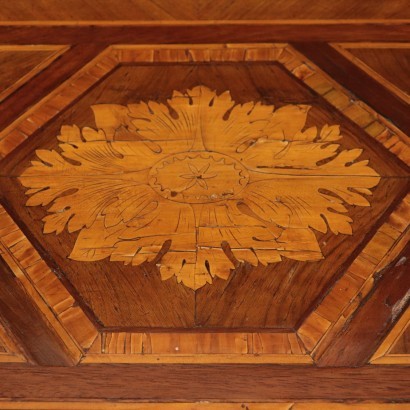Tavolino da Gioco Neoclassico Lombardo
Features
Style: Neo-Classical (1765-1790)
Age: 18th Century / 1701 - 1800
Origin: Lombardia, Italy
Main essence: Maple , Amaranth , Cedar , Walnut
Description
Sorretto da quattro gambe con dado nella parte inferiore e strozzate da un collare nella parte superiore. Interamente intarsiato in noce, cedro, amaranto e acero. Al centro del piano, sia aperto che chiuso, riproduce dei rosoni che presentano delle stringenti somiglianze con alcuni di quelli proposti in disegni appartenenti al Fondo Maggiolini, conservato presso il Gabinetto dei Disegni del Castello Sforzesco di Milano.
Product Condition:
Prodotto in discrete condizioni che mostra alcuni segni di usura.
Dimensions (cm):
Height: 79,5
Width: 77,5
Depth: 42,5
Maximum size (cm):
Depth: 85
With certificate of authenticity
Certificate issued by: Enrico Sala
Additional Information
Style: Neo-Classical (1765-1790)
This historical period includes a first phase that can be properly defined as the Louis XVI style.
nOnly at a later time, with the maturation of archaeological fashions, was a new vision of furnishing civilization formulated and codified, now fully attributable to the Neoclassical Style.
In fact, both trends coexisted in unison until the last years of the eighteenth century.
nIn the field of cabinet making, the Directoire, Retour d'Egypte, Consular and Empire styles also fall within the neoclassical era.
nFind out more about Neoclassicism with the insights from our blog...
n
Age: 18th Century / 1701 - 1800
18th Century / 1701 - 1800 Main essence:
Maple
Hard, light wood used for inlays. It grows mainly in Austria, but it is widespread throughout the northern hemisphere, from Japan to North America, passing through China and Europe. It is one of the lightest woods ever, tending to white, it is similar to lime or birch wood. The briar is used in the production of ancient secretaires .
Amaranth
It is a very hard wood, coming from Guiana and Latin America in general. Very valuable, it is also known as "purple wood" because it has a very reddish color when it is cut, but when it is seasoned it changes to a crimson hue. Widely used by French cabinetmakers, especially in inlays, often combined with bois de rose, and sometimes as a veneer.
Cedar
Coniferous wood, originally from Lebanon in its most widespread variant, was already used by the ancient Egyptians in the construction of boats and coffins. The biblical quotation that notes that Solomon's palace had 45 columns of cedar is significant. Light in color, with a beautiful reddish vein and a characteristic and appreciated fragrance, it was used by French cabinetmakers especially for inlays and also in the creation of small objects.
Walnut
Walnut wood comes from the plant whose botanical name is juglans regia , probably originally from the East but very common in Europe. Light or dark brown in color, it is a hard wood with a beautiful grain, widely used in antique furniture. It was the main essence in Italy throughout the Renaissance and later had a good diffusion in Europe, especially in England, until the advent of mahogany. It was used for solid wood furniture and sometimes carvings and inlays, its only big limitation is that it suffers a lot from woodworm. In France it was widely used more than anything else in the provinces. In the second half of the eighteenth century its use decreased significantly because mahogany and other exotic woods were preferred. 



























